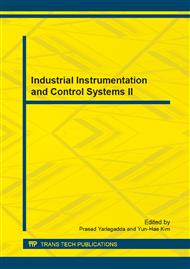[1]
R. Lysaght, H. Ouellette-Kuntz and C.J. Lin, Work, Vol. 41, 4 (2012), pp.409-422.
Google Scholar
[2]
J. Ojasalo, H. Seppa¨la¨, N. Suomalainen and R. Moonen: Better Technologies and Services for Smart Homes of Disabled People: Empirical Findings from an Explorative Study among Intellectually Disabled, 2010 2nd International Conference on Software Technology and Engineering (2010).
DOI: 10.1109/icste.2010.5608845
Google Scholar
[3]
J.M. ALJa'am, S. ElSeoud, A. Edwards, M.G. Ruiz and A. Jaoua: An Assistive Computerized System for Children with Intellectual and Learning Disabilities, 7th International Conference on Smart Homes and Health Telematics, ICOST 2009 (2009), pp.9-16.
DOI: 10.1007/978-3-642-02868-7_2
Google Scholar
[4]
M. Murugappan, R. Nagarajan and S. Yaacob: Comparison of Different Wavelet Features from EEG Signals for Classifying Human Emotions, 2009 IEEE Symposium on Industrial Electronics and Applications, ISIEA 2009, Vol. 2 (2009), pp.836-841.
DOI: 10.1109/isiea.2009.5356339
Google Scholar
[5]
F.J. Hernández, A.M. Zorrilla and B.G. Zapirain: Management Platform to Support Intellectually Disabled People Daily Tasks Using Android Smartphones, 3rd International Symposium on Ambient Intelligence, ISAmI 2012, Vol. 153 AISC (2012).
DOI: 10.1007/978-3-642-28783-1_15
Google Scholar
[6]
T. -F. Wu, M. -C. Chen and C. -F. Wu: The Performance of Mouse Proficiency for Adolescents with Intellectual Disabilities, 12th International Conference on Computers Helping People with Special Needs, ICCHP 2010, Vol. 6180 LNCS, PART 2 (2010).
DOI: 10.1007/978-3-642-14100-3_7
Google Scholar
[7]
J. De Boeck, J. Daems and J. Dekelver: Spe-Ler: Serious Gaming for Youngsters with Intellectual Disabilities, Computers Helping People with Special Needs. 13th International Conference, ICCHP 2012 (2012), pp.479-483.
DOI: 10.1007/978-3-642-31522-0_72
Google Scholar
[8]
I. Ruiz, B. Garcia and A. Mendez: Technological Solution for Independent Living of Intellectual Disabled People, 10th International Work-Conference on Artificial Neural Networks, IWANN 2009 Workshops (2009), pp.859-862.
DOI: 10.1007/978-3-642-02481-8_130
Google Scholar
[9]
U. Cress, K. Wodzicki, M. Bientzle and A. Lingnau, International Journal of Computer-Supported Collaborative Learning, Vol. 6, 2 (2010), pp.307-321.
DOI: 10.1007/s11412-010-9105-5
Google Scholar
[10]
T. Keskinen, T. Heimonen and M. Turunen: SymbolChat: Picture-Based Communication Platform for Users with Intellectual Disabilities, Computers Helping People with Special Needs. 13th International Conference, ICCHP 2012 (2012), pp.279-286.
DOI: 10.1007/978-3-642-31534-3_43
Google Scholar
[11]
L. An and T.J. Sullivan, A user-friendly ssvep-based brain-computer interface using a time-domain classifier. Journal of Neural Engineering, Vol. 7, 2 (2010), p.026010.
DOI: 10.1088/1741-2560/7/2/026010
Google Scholar


